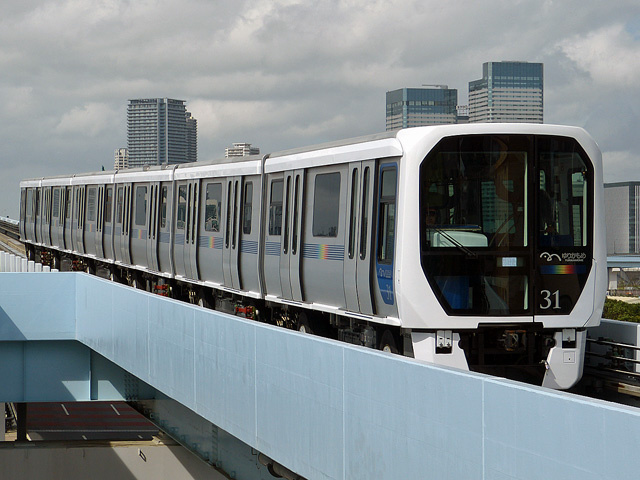Edit 2 October 2019: Updated prices to reflect the increase in Japan's national sales tax.
Odaiba (お台場, lit. 'cannon battery') is an island in Tokyo Bay. It is one of several manmade islands built in the 1850s, to protect the city and its waterfront from attacking ships. In the early 1990s, city planners attempted to develop the island into a futuristic residential and commercial zone, but progress on that front slowed to a halt over the next few years. From the end of the decade, however, the area was revitalised by a series of shopping malls, entertainment complexes, and hotels.
 |
| A 7300-series Yurikamome train approaching Ariake Tennis-no-Mori Station. By Nyohoho [CC BY-SA 3.0], from Wikimedia Commons |
The first few segments of the Yurikamome run parallel to other lines, including the high-speed Shinkansen. This is an N700-series Shinkansen, the latest model to run on the Tokaido line, between Tokyo and Osaka.
The Yurikamome track then loops around part of Tokyo Bay, giving a view of the ships docked below.
Afterwards, the Yurikamome travels along the Rainbow Bridge (レインボーブリッジ, Reinbō Burijji). Opened in 1993, the Rainbow Bridge spans the Tokyo Bay. At night, the spans are lit up either in white or in a rainbow pattern.
I got off at Daiba Station. From this angle, facing northwest from the island, the Rainbow Bridge and Tokyo Tower can be seen. But what's that off to the right...?
Yes, that is a replica of the Statue of Liberty. This is actually one of many official replicas built by the French government, which made the original one for New York Harbour in 1886. One way this differs from the original, apart from its size, is on the tablet. The dates here refer to the American Revolution (4 July 1776) and French Revolution (14 July 1789).
Odaiba is famous for its futuristic architecture. In the foreground is the Aqua City shopping mall, and in the background is the Fuji TV building. The sphere in the latter houses an observatory open to the public.
Even more architecture. The arch-like building in the far background is the Telecom Centre, a multipurpose office building. The Tokyo Big Sight convention centre (not pictured), which hosts regular events such as Comiket and AnimeJapan, is also nearby, on the next island over.
A full-scale statue of the RX-78 robot from the Mobile Suit Gundam franchise. It stands in front of the Diver City mall, which also hosts the Gundam Front attraction.
The Cirque du Soleil production Ovo ran here in Odaiba, from 12 February to 29 June 2014.
Palette Town is an entertainment complex hosting, et al, the Venus Fort shopping mall, Toyota Mega Web, and a 115-metre (377-foot) tall Ferris wheel called the Daikanransha (大観覧車, lit. 'giant sky wheel').
At night, the side walls of Venus Fort light up in patterns such as this...
...as does the Daikanransha.
Even more coloured lighting in a tunnel entrance to Palette Town.
Closing out this article with a night shot of the Gundam Statue again. There is so much to see and do in Odaiba that I'll have to dedicate a few articles to specific sites! I shall start with the Venus Fort mall, and its Toyota MegaWeb attraction, next time on Sekai Ichi!
Access: Two lines serve the Odaiba district. The Yurikamome (U), mentioned earlier, is an above-ground line running between Shimbashi (JR Yamanote (JY), Tokaido (JT), Keihin-Tohoku (JK), Yokosuka (JO), Tokyo Metro Ginza (G), and Toei Asakusa (A) lines) and Toyosu (Tokyo Metro Yurakucho (Y) line) stations. The sites covered in this article are nearest to the Odaiba Kaihin-koen, Daiba, and Aomi stations.
The other line, the Rinkai (R) Line, runs underground between Osaki (JR Yamanote, Saikyo (JA), and Shonan-Shinjuku (JS) lines) and Shin-Kiba (JR Keiyo (JE), Musashino (JM), and Tokyo Metro Yurakucho lines) stations. It does not offer the same scenic views as the Yurikamome, and only stops at one station on the island, the centrally-located Tokyo Teleport station.
From Tokyo Station, take the Yamanote or Keihin-Tohoku lines to Shimbashi (JY27/JK24, 3 minutes, ¥140), and then take the Yurikamome to your desired stop (13-20 minutes, ¥330-390). From Shinjuku Station, take the Saikyo line to Tokyo Teleport (R04, 23 minutes, ¥510). Most trains continue on to the Rinkai line to reach Tokyo Teleport; if your train does not, transfer at Osaki Station (JA08).














